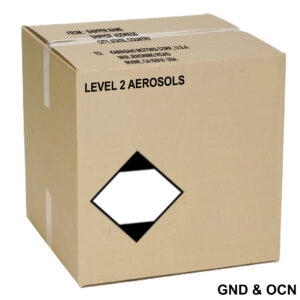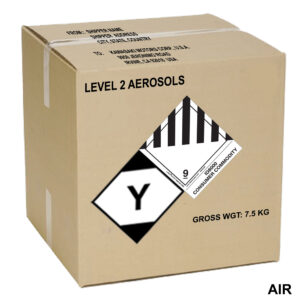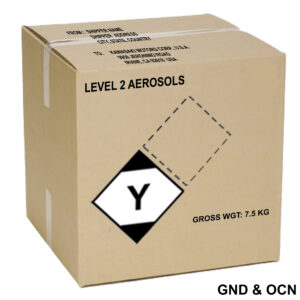Written on: November 1, 2014 by SprayTM


A couple of weeks ago I received several phone calls from a number of cosmetic manufacturers that were having issues with certain carriers regarding the marking of limited quantities. There appears to be some confusion with respect to the marking of limited quantities by surface, air and ocean, when the “Y” marking is appropriate and when it isn’t, and what size the limited quantity marking must be.
I thought I would clarify some of these questions and offer example illustrations of limited quantities for various modes of transport.
Limited Quantities
A limited quantity of a hazardous material means the maximum amount of a hazardous material for which there is a specific labeling or packaging exception. Whether or not a hazardous material may be shipped as a limited quantity is dependent upon the following factors: (a) the hazard class and division for the substance or article; (b) the size of the inner receptacle; and, (c) the total gross mass of the completed package.
Only certain classes and divisions of dangerous goods may be offered as limited quantities. For transport by vessel, the International Maritime Dangerous Goods (IMDG) Code prohibits all Packing Group I dangerous goods from being offered as limited quantities. For transport by air, the International Civil Aviation Organization (ICAO) Technical Instructions further restrict limited quantities to only certain classes and divisions in Packing Groups II and III, and further prohibits certain substances within those classes and divisions from being shipped.
Experience has proven that many dangerous goods can be shipped safely in strong outer packaging that is capable of meeting the design, construction and performance tests outlined in the regulatory requirements, but which have not been tested. Thus, limited quantities need not be packaged in expensive UN-performance-oriented packaging that has been tested and marked accordingly. There are also certain economic advantages to shipping a hazardous material as a limited quantity, including reduced hazard communication requirements for surface and ocean transport and an exception from the shipping paper requirements for surface transport. Additionally, many carriers have reduced shipping rates or surcharges for limited quantities compared to fully-regulated dangerous goods shipments.
The maximum quantity permitted per inner receptacle (the immediate form of containment) may differ between modes of transportation. For example, a limited quantity of a flammable aerosol is restricted to 1L per can for surface and ocean transport whereas the same product is further restricted to 500mL when offered by air.
Hazard Communication
Packages containing substances and articles offered as dangerous goods in limited quantities must be properly marked and described on a shipping paper, if the shipping paper is required. However, there are important differences in the marking and labeling requirements for different modes of transportation.
For example, a 12-count package containing 16 oz. flammable aerosol (NFPA Level 2) spray lube may be offered as follows:

Limited quantities of dangerous goods prepared for surface and ocean transport must be marked with the limited quantity “hollow diamond with black points” marking, whereas packages of limited quantities offered for transport by air must have the “limited quantity Y” marking in addition to the hazard class warning label, proper shipping name and identification number.
Marking Requirements
The square-on-point marking must be durable, legible and of a size relative to the package as to be readily visible. The limited quantity marking must be applied on at least one side or one end of the outer packaging. The width of the border forming the limited quantity marking must be at least 2mm and the minimum dimension of each side must be 100mm unless the package size requires a reduced size marking that must be no less than 50mm on each side.
The top and bottom portions of the square-on-point and the border forming the limited quantity markings must be black and the center white or of a suitable contrasting background and the symbol “Y” must be black and located in the center of the limited quantity marking. Limited quantity markings may use the packaging itself as the contrasting background for the center portion of the marking if the color sufficiently contrasts so that the black border, top and bottom portions of the limited quantity marking, and the “Y” symbol, if applicable, are clearly recognizable.
As an alternative, a packaging may display the limited quantity “Y” mark if the package conforms to authorized substance and article provisions and the inner and outer package quantity limits prescribed in 49 CFR §173.27(f).
An example is shown below:

Size Matters
The limited quantity marking must be 100mm x 100mm; however, a reduced-size marking between 50mm and 100mm may be used in place of a corresponding marking that otherwise conforms to the requirements of the Hazardous Materials Regulations (HMR), which permits use of a reduced-size hazard marking when a package surface is too small or of an irregular shape for a full size marking.
The HMR does not prohibit the placement of a limited quantity marking in an orientation where the square-on-point is located with its flat sides parallel to the sides of the packages. A limited quantity marking that otherwise conforms to the requirements of the HMR may be placed square-on-side when the square-on-point is not practicable if the package surface is too small or of an irregular shape for a full size marking.
However, the square-on-point configuration is the preferred (recommended) method for displaying the limited quantity marking required by the HMR. It is important to note, though, that some carriers and foreign competent authorities may not accept shipments where the limited quantity marking is placed on the package in a square configuration where the sides are parallel to the edge of the box.
The U.S. Dept. of Transportation (DOT) also permits the marking size to be reduced to less than the 100mm per side standard (but not less than 50mm) to the extent necessary to accommodate pre-printing of additional information needed with the limited quantity marking such as bar coded shipping labels.
For additional information on limited quantity markings, you may contact the DOT Pipeline & Hazardous Materials Administration (PHMSA) website or ShipMate, Inc. at (310) 370-3600.